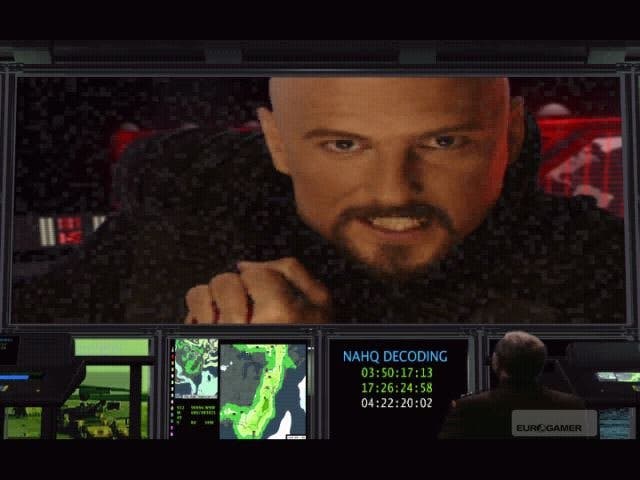Retrospective: Command & Conquer - The Tiberian Saga
The land of Nod.
"What's really interesting about this is that this story was written between '93 and '95," muses Castle. "Many years before where we are today. But it has striking similarities, because the really bright people who wrote these stories were looking at world events and saying, 'You know, the real enemy of the future isn't a rogue nation. It's not the cold war. The real enemy is a non-government body, a loose connection of terrorist cells, and if there was one charismatic leader who could come along and get them to take action, that could really change the world.'"
Spooky foresight and wobbly FMV weren't C&C's only innovations. The campaigns may have explained the basics and got the storyline moving, but Tiberian Dawn's multiplayer set new standards, allowing for four-player games over a network or modem, and supported with two expansion packs that only added to the options. When it wasn't redefining group time-wasting, Westwood also introduced the world to the talents of one Joe Kucan, the studio's recently hired director of dramatic assets, who boldly leapt into the role of Kane, and made it his own. With an acting style that can best be described as sub-WWE, he's been an endearing presence in the game ever since, utilising little-known high-level thesp skills such as speaking rather slowly, and staring. You know, really staring.
Even without his goateed charms, Tiberian Dawn would still have been a landmark, however: this was the game that solidified the conventions of the genre that Dune II had helped establish, and it put some promising narrative elements in play: two factions, both tinged with moral ambiguity, in a heavily-armed fight over a dangerous resource. The stage was set for a prolonged war of attrition - and a lot of right-clicking.
Command & Conquer: Tiberian Sun (1999)
Kane is defeated at the end of Tiberian Dawn, splattered by the GDI's orbital Ion Cannon while gurning messianically, if such a thing is possible, in the Nod Temple in Sarajevo. Following a troubled development, Tiberian Sun emerged four years later to pick up the story.
"Time has passed, and the Nod and GDI have been battling it out for decades now. This is where we start to add a lot of the depth to the game," says Castle. "By now, Tiberium has been proven to be a very toxic substance, the world is starting to get carved up into areas, some clear of the mineral, and some with Tiberium infestation, where the population has mutated. It's pretty clear that GDI thinks they've been right: Tiberium is dangerous, they need to wipe it out, and they don't care about the people who get in the way. Nod, on other hand, has lost its leader, lost purpose and become fragmented. For most of Tiberian Sun, they're behind various different leaders that have popped up - generals who have made themselves self-important."

Then, in the middle of the game, Kane makes his return. "He hasn't been destroyed, and he looks like he did 40 years ago," says Castle. "Whether it's because of experiments he's done before, or whether he's not quite human, we don't really know." He's got luggage, too, having found an alien artefact called the Tacitus - an ancient database, containing a wealth of knowledge regarding the harnessing of Tiberium, which allows Nod to make a dramatic leap in technology.
It's not enough, however, and the GDI finally defeat Kane once more, this time in Cairo (where I would always recommend the Pensione Roma to budget travellers - nice breakfasts and the guy behind the counter looks like George Kostanza), capturing the Tacitus in the process.
But that just leads to further questions. "In the process, the GDI learn about the Scrin," says Castle, "the alien race that has given us the Tacitus. Nobody's really quite sure if the Tacitus was put there for us to find and exploit, or if it was a warning. And that really evolves the mystery of Tiberium: what is it about? Is it a terraforming agent, or is it something else?"
While Tiberium's role in the plot was becoming more elaborate, its role within the game was growing increasingly complex, too, with Tiberian Sun splitting the harvestable - and toxic - crystal into two different strains of varying potency, while introducing veins of the stuff which couldn't be turned into credits at all. Alongside more involved resource-management, the sequel also built upon Hero units, an idea sketched out in Tiberian Dawn and then expanded upon in the first Red Alert title. Powerful toys that gave the player a huge advantage in combat, Hero units also lend a touch of personalised swagger to the faceless armies scurrying around the screen: Tiberian Sun allowed the GDI to mess around with a couple of real meanies drawn from the Forgotten, a motley of human unfortunates mutated by exposure to Tiberium, while Nod had their own powerful Cyborg Commando to blow things up with.
Other tweaks included basic terrain deformation, advanced lighting, and mechs, while Firestorm, an expansion pack, picked up the plot strands just after the end of Tiberian Sun, and featured the struggle against CABAL, an AI built by Kane using knowledge gained from the Tacitus.









